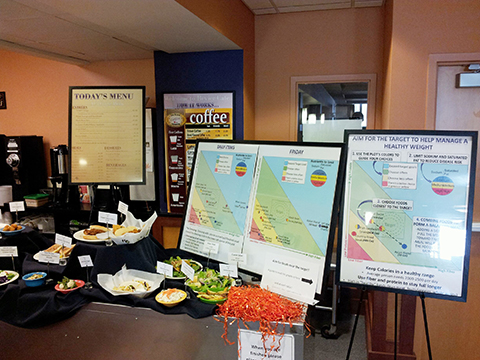Nutrition Graphics Pack More Punch Than Numbers
You’re tired and “hangry” as you step up to place your dinner order at the grab-and-go place in your neighborhood. Though you’re committed to making a good decision, the menu label’s numerical nutrient information is confounding and you lose patience trying to sort through it. You order, but you’re uncertain about the nutritional value of your food. Did you make a good decision?
This scene repeats itself time and again for consumers everywhere, but recent research from the University of Illinois suggests things don’t have to be so confusing. A study published in Nutrition Research (2016; http://dx.doi.org/10.1016/j.nutres.2015.10.009) showed that displaying nutrition information as graphics can help to keep health-conscious eaters on target.
It’s commonly known that diseases such as obesity, diabetes and heart disease can often be prevented or treated by managing the intake of certain nutrients. However, in a time-constrained situation, like standing in line at a cafeteria or restaurant, it can be difficult for consumers to quickly calculate and absorb numerical nutrition data beyond the calorie counts. The team from Illinois found that when people were shown a graphical display of select nutrients on a two-dimensional graph when ordering in a café setting, they purchased healthier, not just lower-calorie, menu items as a meal.
Identifying the best way to present nutrition information is a growing area of research, according to Manabu T. Nakamura, PhD, associate professor of nutrition at U of I. “Current nutrition labels provide comprehensive nutrient information, but unfortunately they’re not [helping consumers to] make decisions in restaurants and grocery stores,” he said.
In order to see if presenting the nutrition information graphically would change diners’ purchasing behavior, Nakamura and his team set up two experiments using a visual, two-dimensional graph showing the fiber and protein per-calorie values for each menu item. The graph also included a target box with the recommended dietary amounts of those nutrients per calorie of food. Researchers plotted fiber and protein values because these two nutrients are closely tied to weight management.
The team began with an experiment to see which helped participants recall nutrition information more successfully: a two-dimensional graph or numerical data. Recall accuracy was up to 43% better with the graph.
The second experiment was a 12-week study of purchasing behavior in U of I’s Bevier Café. In this setting customers stand in line to order and pay for their food at registers near the entrance of the café.
During some weeks of the study, menu items were plotted on the two-dimensional graph according to their fiber, protein, saturated fat and sodium per-calorie values; during other weeks, nutrition information was displayed numerically. Facts about managing a healthy weight—such as keeping calories in a healthy range, limiting saturated fat and sodium, and increasing fiber and protein—were signposted near where food was ordered.
Ultimately, when nutrition information was provided as a two-dimensional graph, consumers purchased fewer calories, but bought more protein per calorie and more items that received high “healthy” ratings on the plot. Nakamura called this a “clear success.”
“This may be the first study that shows unambiguous purchasing changes from displaying the nutrition information [in a new way],” he said.
Photography: Nathan Pratt, University of Illinois
Sandy Todd Webster
For 22 years, Sandy Todd Webster was the chief architect of IDEA's content program - including the award-winning IDEA FITNESS JOURNAL and IDEA FOOD & NUTRITION TIPS - the industry's leading resources for fitness, wellness and nutrition professionals worldwide. She created, launched and nurtured these brands and many others during her productive and purposeful IDEA tenure. Sandy is a Rouxbe-certified professional plant-based cook and a Precision Nutrition Level 1 Coach who is pursuing a Master's degree in Sustainable Food Systems through The Culinary Institute of America (expected August 2024). She plans to combine these passions with her content expertise to continue inspiring others to make the world a more just, healthy and regenerative place.






